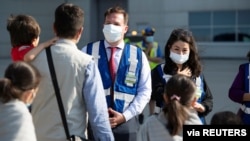The U.S. State Department has referred more than 5,000 Afghan refugees who were seeking admission to the United States to a parallel program in Canada, where waiting times for permanent residence are shorter.
State Department officials confirmed to VOA those referred to the special immigration program are not simultaneously going through the U.S. Refugee Admissions Program (USRAP).
“We are working with Canada to refer up to 5,000 refugees to Canada, independent of our ongoing efforts for U.S. resettlement,” a State Department spokesperson told VOA.
On the Canadian side, Immigration, Refugees and Citizenship Canada (IRCC) said Afghan refugees referred by the U.S. are coming to Canada from third countries, where they have been located since they fled Afghanistan.
Masuma Haidari, 37 and a software engineer in Afghanistan, is one of the people benefiting from the partnership between the two countries. She was able to leave Afghanistan in August 2021 and lived in North Macedonia for more than six months.
Private organizations helped her leave Afghanistan and find her way through the program that led her to Canada.
Haidari told VOA she was about to get the keys to her first apartment in Calgary, Canada.
“It’s not bad,” Haidari said. “The government helps us with money and we (must) manage to cover all costs.”
But with her background in software engineering and having worked for the Afghan government, she hopes it will be useful in her new Canadian life.
“I think that the technical experiences will be useful in Canada. I will try to [transfer] my degree, my education and also I will be ready to find a job in the IT industry,” she added.
Though Haidari is able to start a new life, thousands of people are still hoping to leave Afghanistan.
Rescue efforts
U.S. military veterans, former intelligence and defense officials and others have dedicated their time to rescue those still in Afghanistan through newly formed groups like Operation North Star, which is all volunteer, or Task Force Pineapple, which is a public-private partnership.
Getting people out of Afghanistan is just part of the problem.
According to the Operation North Star website, they have almost 500 Afghans in third countries and more than 2,000 Afghans in safe homes in Afghanistan. Equally challenging has been guiding the Afghans through the complex process to resettle in the United States, including finding safe homes, leaving Afghanistan, finding a third country, applying to a refugee program and arriving in a new country.
The U.S. immigration system includes a patchwork of complex laws for regulating the flow of refugees seeking to enter the United States. The U.S. manages a strict vetting process to determine who to accept for resettlement and the process can take two to five years.
Slow U.S. processing is prompting some private groups to look elsewhere for a permanent home for the evacuees, with immigrant-friendly Canada emerging as a favored destination.
So far in Fiscal 2022, which began October 1, 2021, 133 Afghans were admitted into the U.S. through USRAP. In Fiscal 2021, that number was 872. Through the Special Immigrant Visa program, which is for those who served as interpreters and translators or were employed by or on behalf of the U.S. government, the U.S. admitted 1,545 refugees in Fiscal 2022.
Jordan Kane, a volunteer at U.S.-based Operation North Star, said it has been difficult to secure U.S. refugee status for Afghans who have been recommended for relocation by the U.S. Embassy in Kabul, the U.N. High Commissioner for Refugees or a designated NGO. After the referral, it still takes at least two years for applicants to arrive in the United States.
“Thousands of Afghan refugees who had secured limited referrals to the U.S. resettlement process were given an option to be switched over to the Canadian process, with women leaders fleeing Taliban threats receiving preference,” Kane told VOA.
The U.S. Refugee Admissions program was dramatically cut under the Trump administration, leaving fewer resources within the government and the resettlement agencies to handle the significant increase of refugee applications and arrivals.
Resettlement in Canada
Once the U.S. identifies Afghan refugees who meet eligibility and admissibility requirements, they are then accepted for resettlement to Canada.
“As government-assisted refugees, Afghan refugees become permanent residents upon arrival and have access to the Resettlement Assistance Program (RAP),” according to Jeffrey MacDonald, communications officer at IRCC.
The Canadian government provides temporary housing and up to 12 months of income support.
“Monthly income support levels for shelter, food and incidentals are guided by provincial or territorial social assistance rates where the refugee resides and vary depending on family size, configuration and city of residence,” MacDonald said in an email to VOA.
One refugee, whose case was transferred to Canada, is identified for security reasons only as “Farishta.” She was a women’s rights activist and prosecutor in the office of the Afghan attorney general.
“The Canadian program under which Farishta is applying is unique,” Kane said. “Like the U.S., Canada has a program for resettling Afghans who worked for them, who are mostly male military interpreters. However, unlike the U.S., Canada also has a program for admitting other groups of Afghans targeted by the Taliban, including female leaders, which is great.”
The Women at Risk Program recognizes the women and girls particularly vulnerable in refugee situations and prioritizes their resettlement to Canada.
“But Canada shouldn't be the only country looking out for women like Farishta,” Kane said, adding, “the U.S. and other NATO allies need to copy this program to make sure we are not leaving Afghan women behind.”
The Canadian government has committed to accept 40,000 Afghan refugees. Included in that number are the 5,000 people being referred through the partnership with the United States. From August 2021 to March 2022, the country has admitted 8,815 under all available refugee categories.
Canada has a biometric verification process that refugees must complete before they enter Canada, according to Oliver Thorne, who is the executive director at the Vancouver-based Veterans Transition Network.
“Although these are Afghans that risked their lives to support and in many cases, save the lives of Canadian soldiers, our government policy will not allow them into Canada without biometric verification,” Thorne told VOA.
Thorne said the Canadian government policy needs to align with the urgency of these evacuation efforts and allow for biometrics to be done after arrival in Canada.
“Without this, evacuations will proceed at a trickle pace, leaving brave and deserving Afghans at risk of reprisals from the Taliban,” he added.
MacDonald, of the IRCC, responded that the biggest hurdle “is not the processing capacity of the government of Canada, it’s situational and environmental factors on the ground in Afghanistan. These are challenges that we are working on every day, there’s no lack of effort on the part of the government of Canada.”
Nevertheless, the private groups credit Canada for taking in a number of Afghans who might not be eligible for resettlement elsewhere. Most countries are offering visas to a limited number of Afghans who worked directly for them, refugee advocates said.
As for Farishta, she had hoped to resettle in the United States, Kane said.
“The United States was Farishta's first choice, because she has more friends there, but she considers Canada to be a great option. … Two reasons for this: she, like many educated Afghans, speaks fluent English already. Second, Canada has more generous resettlement benefits than the U.S.,” Kane said





